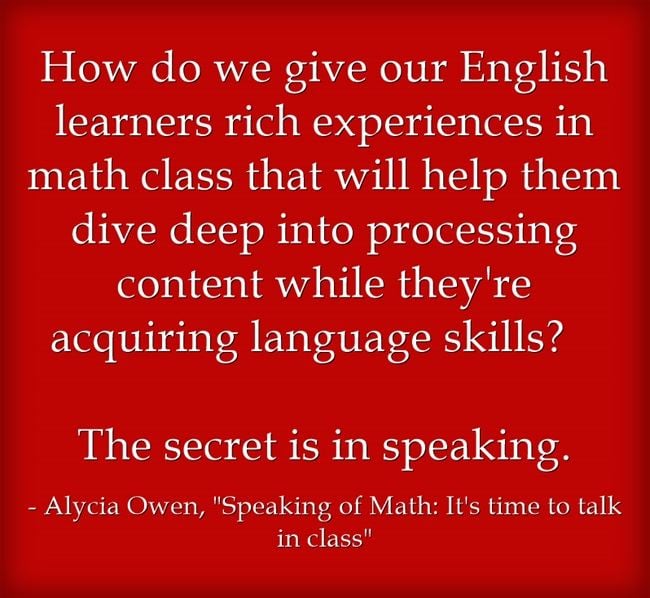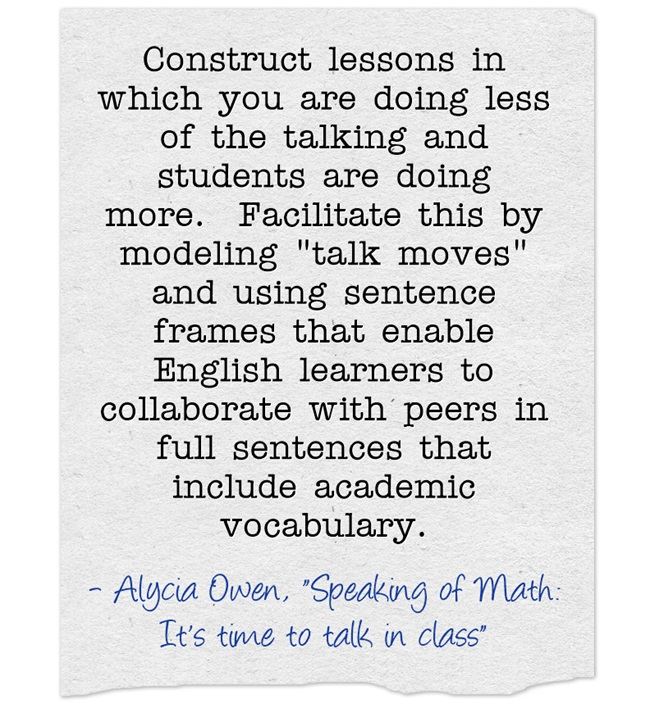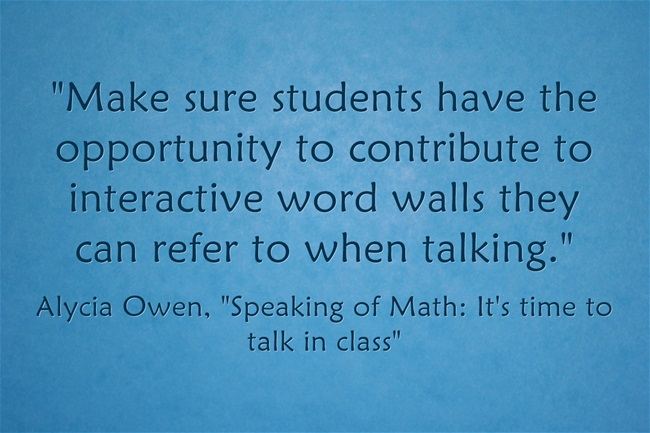Editor’s Note: This is the first in a series of guest posts that will be appearing on this blog about teaching math to English Language Learners. I’ll be posting them over the next six weeks, and adding each one to The Best Resources For Teaching Common Core Math To English Languag....
By Alycia Owen
Alycia Owen is an international educator, instructional coach, and EAL specialist who has implemented the co-teaching model in math, science, and language arts. She has provided professional development for schools in the US and abroad and has been a workshop presenter at NESA, AASSA, and EARCOS international teachers’ conferences. She currently lives in China where she serves on the faculty of the American International School of Guangzhou.
“We are all teachers of language.” As educators, we know this to be true. It’s fairly easy to identify why a science teacher would teach students how to format lab reports, for example. Or, the value of the history teacher addressing how to differentiate between primary and secondary sources. There are countless examples of language objectives that support learning outcomes in the content areas. But how do we give our English learners rich experiences in math class that will help them dive deep into processing content while they’re acquiring language skills?
The secret is in speaking.
Math class requires students to conjecture, reason, argue, prove, critique, explain, analyze, interpret, model, question, discern, compare, describe, and justify. While reading, writing, and listening are integral to the learning of mathematics, it is the speaking tasks that allow students to engage more fully in mathematical practices. The classroom should reflect the vital role that speaking plays in math. It should facilitate collaboration, make specialized math language accessible and visible, and provide a wide variety of opportunities for students to speak the language of math.
Set the Stage for Collaboration
The organization and layout of the physical space in the classroom is an important first step in establishing the types of discourse that are valued and utilized in that environment. English language learners construct meaning by using language in context as they collaborate with peers. The classroom must support this by offering flexible seating arrangements that allow for partners and small groups to collaborate often. Space for students to use manipulatives and model their thinking should also be considered. Next, procedural norms should be explicitly modeled and reinforced for students. For example:
- How and why to make eye contact when someone is speaking. This will look different during whole class vs. partner activities. Make these differences transparent to students.
- Introduce a quiet signal that includes what to do with both the voice and hands when the teacher needs students’ attention during discussions and group work. Students will be talking while working with manipulatives and need a signal that helps them seamlessly move from high activity into focused attention on the teacher.
Lastly, and most importantly, construct lessons in which you are doing less of the talking and students are doing more. Facilitate this by modeling “talk moves” and using sentence frames that enable English learners to collaborate with peers in full sentences that include academic vocabulary.
The Language of Math
To speak the language of math requires the use of specialized vocabulary and symbols to build meaning and to understand concepts. Make sure students have the opportunity to contribute to interactive word walls they can refer to when talking. Take care to identify words that have different meanings in and out of math class and model their varying uses. Here are a couple of my favorites: He was a great ruler of his kingdom. vs Use a ruler to measure the book. Or, I heard about that product on a commercial. vs The product of 5 and 7 is 35. It’s also helpful to translate number sentences into words and post the two versions. 58 + 3 = 61/Fifty-eight plus three equals sixty-one. Lastly, have students create a math dictionary as the school year unfolds (alternatively, a mini-dictionary for each unit). This can be a small spiral notebook or even some stapled sheets of paper with a construction paper cover. As a term is introduced and added to the word wall, students update their dictionaries with the new word, its definition, and an example or picture. This way, when a word is removed from the wall to make space for others, students still have a reference tool they can use independently. The dictionary has the added benefit of providing a tangible reminder of how much has been learned, which goes a long way toward helping English learners feel proud of their efforts and motivated to keep talking.
Time to Talk
If teachers should be talking less and students talking more, what should they be talking about? How do I fit speaking into lessons that are already packed with content and activity? I’ve discovered it’s almost always a good time to talk in math class. Here are some opportunities for speaking practice that require no extra preparation because you’re probably already doing them. With academic vocabulary visible in the room and a sentence stem or two to guide them, use a pair/share or small-group format so your students can talk to each other about:
- Word problems (What key words can you find to help us solve it? What strategy should we use? Why did you choose that strategy?)
- Warm-ups (Did you and your partner get the same result? Use the same strategy?)
- Using Manipulatives (This model shows _____.)
- Graphic Organizers (Use your _____ to explain _____ to a partner.)
- Math Dictionaries (Look at your partner’s dictionary and find something to compliment.)
- Math Journals/Written Reflections (Tell your partner what you plan to write. Read your journal entry aloud to your partner.)
- Projects (Share your progress with a partner. What have you accomplished so far? What do you still need to do?)
- Check-ins (The most challenging thing about today was ______. I now understand ______.)
Any time students are talking, circulate to listen in on conversations and participate when you think it’s appropriate. You’ll get immediate formative data and even more opportunities to model math vocabulary, including how to use any sentence frames you’ve provided. It’s also a nice time to validate students’ thinking, ask guiding questions, encourage elaboration and clarify misunderstandings.
Speaking of math… If in every class meeting, every student has a chance to talk using the language of math, their confidence will grow right along with their competence. Even math anxiety can be made less severe or eliminated when students know they have peers to talk with, ideas worth sharing and when the language of math is made transparent and accessible to all. Now THAT’s something to talk about!



You need to be a member of School Leadership 2.0 to add comments!
Join School Leadership 2.0